The history of lavender
Robert Clark falls in love with lavender.


Elizabeth I carried posies of lavender and had it scattered before her, to fend off stenches and the plague. Queen Victoria preferred lavender jelly to mint with her roast mutton and, from about 1800 to the 1930s, no genteel lady went abroad without a flask of English lavender in her reticule.
But then French fashions became the rage and, at the same time, plants at the largest English growers, in Mitcham, Surrey, succumbed to shab, a fungal disease. Until some 20 years ago, English lavender was in decline, with only the Norfolk Lavender farm at Heacham keeping the commercial flame alive.
Today, you might think nearly all lavender oil comes from Provence, but, in fact, English lavender is resurgent, with multiple small producers. Often, they also run a gift shop and restaurant, which attract customers like bees to the flowers.
English lavender’s resurgence is partly due to French production being in decline, but is also because so many of today’s perfumes are multinational chemical concoctions. Venerable perfume houses have been taken over, centuries of tradition turned into empty slogans. Even Grasse, that famed centre of the French perfume business, now has a slender relationship with the hills around it.
It was this historical conjunction that found fertile soil in Richard Norris’s head nearly 20 years ago. He had trained as an accountant, but, in his heart, he wanted his own business and knew it had to do with plants. His damascene moment came when reading an article by Jamie Compton about the history of English lavender.
He was smitten and with what better plant, what richer history? Lavender is ancient, venerable, magical. It was prescribed by Dioscorides, the Greek surgeon whose De Materia Medica became the pharmaceutical bible for 1,500 years. Dioscorides knew it protects you from plague (but not why fleas, the transmitter, abhor it) and that it helps wounds heal (lavender is antibacterial and antiseptic). The Romans put bunches between their sheets to guard against bedbugs and washed their clothes with it to repel moths and lice (whence its name, from lavare, to wash).
Plant enough of it in your garden and you will have fewer snails, slugs and aphids, but bees and butterflies will come in swarms, drawn by the abundant nectar. How not to fall in love with lavender?
Exquisite houses, the beauty of Nature, and how to get the most from your life, straight to your inbox.
Richard therefore bought the site of The Old Sheep Fair near Alresford in Hampshire and set about establishing Long Barn Lavender (www.longbarn.co.uk). He waxes lyrical on his subject, fascinated by lavender’s history and entirely in love with what he’s doing.
He’s the first to admit it’s against Nature that English lavender should be so special. Lavender isn’t a native of these islands. It is native to southern Europe, the Middle East, Persia, parts of Africa and Asia, thriving on alkaline, fast-draining hillsides. It needs grazing by goats to stop it getting woody (gardeners please note: cut it back to about 8in every year and it will last decades).
Until the 1920s, it wasn’t cultivated in France, the perfumiers of Grasse relying on cueillette sauvage of Lavandula stoechas, by peasants whose back-breaking labour produced a valuable cash supplement to see them through the winter months.
However, haphazard collection made for variable quality, whereas English lavender, grown commercially, was a fine, consistent product worth as much as six times the French price, hence the oxymoron ‘English’ lavender. Over the years, the English produced cultivars of Lavandula angustifolia that would make the most compact and floriferous plants and be best able to tolerate our colds and damps.
Lavandula Hidcote, cultivated in the 1910s by Lawrence Johnston, is generally considered among the very best, alongside Munstead, Gertrude Jekyll’s favourite. Hidcote is now the plant of choice worldwide for garden use, due to its rich purple colour.
Richard himself, however, leans towards Lavandula x inter-media, which has a cleaner and more uplifting scent, and especially recommends the cultivar Grosso, which flowers long and abundantly, produces a superb scent beloved by bees and is easily pruned to a compact form.
Country Life is unlike any other magazine: the only glossy weekly on the newsstand and the only magazine that has been guest-edited by His Majesty The King not once, but twice. It is a celebration of modern rural life and all its diverse joys and pleasures — that was first published in Queen Victoria's Diamond Jubilee year. Our eclectic mixture of witty and informative content — from the most up-to-date property news and commentary and a coveted glimpse inside some of the UK's best houses and gardens, to gardening, the arts and interior design, written by experts in their field — still cannot be found in print or online, anywhere else.
